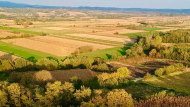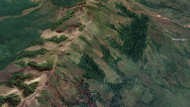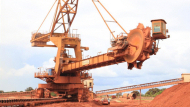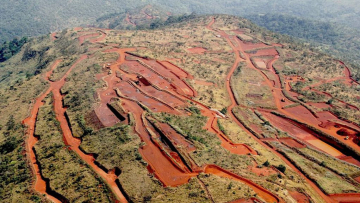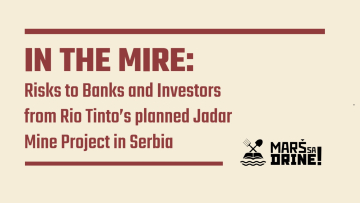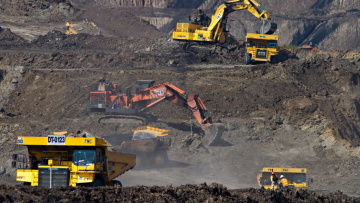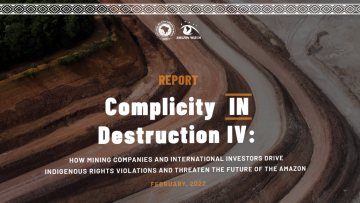
Company – Active
This profile is actively maintained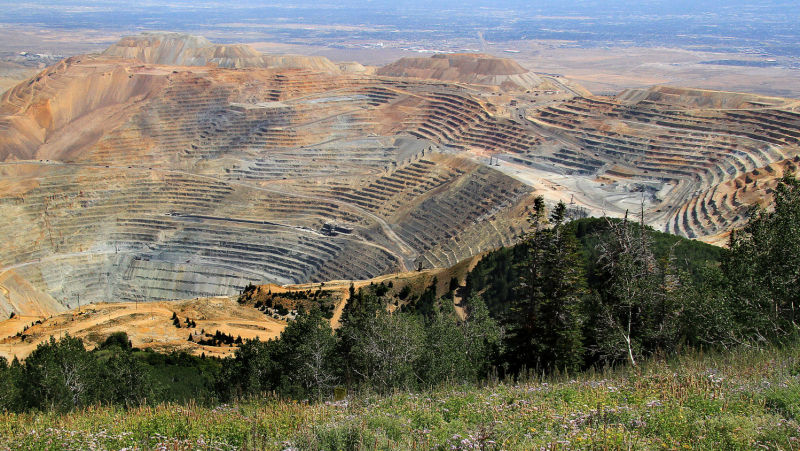
Company – Active
This profile is actively maintainedWhy this profile?
Rio Tinto has drawn sustained criticism for its adverse impacts on communities and ecosystems, particularly through its extractive projects such as the Simandou iron ore mines in Guinea, the proposed Jadar lithium mine in Serbia, the Bougainville mine in Papua New Guinea, and the Juukan Gorge cave in Western Australia. These have been linked to forced displacement, environmental degradation, destruction of culturally significant sites and violations of indigenous rights.
What must happen
Banks must urgently take action requiring Rio Tinto to comply with international human rights and environmental standards as a prerequisite for financing. Additionally, Rio Tinto must take responsibility for harms caused by its global operations, including the remediation of affected communities.
| Sectors | Mining, Nuclear Electric Power Generation |
| Headquarters |
|
| Ownership |
Shareholders. Rio Tinto plc is listed at the London Stock Exchange and Rio Tinto Ltd is listed at the Australian Securities Exchange. |
| Subsidiaries |
|
| Website | http://www.riotinto.com |
Rio Tinto is a British-Australian multinational mining and exploration company with joint headquarters in London, UK, and Melbourne, Australia. It has over 60 projects and operations in 35 different countries and produces commodities such as iron ore, copper, uranium, aluminium, lithium, diamonds, gold and other industrial minerals. The company is the second-largest mining company in the world by market capitalisation after BHP, as of 2025.
Impact on human rights and communities
Impacts on health and livelihoods Between 1972 and 1989, Rio Tinto operated the Panguna mine in Papua New Guinea, which discharged over a billion tonnes of mine waste into rivers. A 1989 uprising forced the mine’s closure and triggered a decade-long civil war, killing an estimated 20,000 people. Rio Tinto divested from the mine in 2016 without contributing to clean-up. In 2020, an OECD NCP complaint led to the 2024 Panguna Mine Legacy Impact Assessment, which confirmed the Bougainville communities’ long-standing claims of enduring environmental and human rights violations. The HRLC continues to demand Rio Tinto take remedial action.
Rio Tinto also owns 80% of the QIT Madagascar Minerals (QMM) project in Madagascar, operating an ilmenite mine since 2009. A 2019 Andrew Lees Trust (ALT) UK study found that water near the mine had uranium and lead levels 52 and 40 times above the World Health Organisation’s safe drinking water guidelines. Some 15,000 nearby residents rely on these water sources for drinking, fishing, agriculture, and domestic use. Publish What You Pay Madagascar documented adverse impacts on living conditions, livelihoods, and access to food and water.
Conflict with communities, coercion, and intimidation In 2022, thousands protested in Madagascar after a tailing dam failure at Rio Tinto’s QMM mine released 264 million gallons of toxic waste into local streams. Protesters were met with violence, and many activists were injured or arrested. In response, Rio Tinto launched a conflict resolution process, which communities alleged was mired in human rights violations, including intimidation and coercion. Following further protests in 2023, three human rights defenders were shot and killed.
Similarly, in South Africa, Rio Tinto’s Richards Bay Minerals subsidiary suspended its Zulti South project in 2021 due to security concerns and conflict with communities. Local communities had protested the mine’s expansion, which was met with police violence.
Lithium mining risks in Argentina: In March 2022, Rio Tinto began constructing a lithium processing plant in Salar del Rincón, Salta. In 2024, it acquired Arcadium Lithium, making it the third-largest lithium producer globally and growing its influence over Argentina’s lithium sector significantly. This has intensified concerns over the environmental and social impacts of large-scale mining in the region, especially due to the heavy pressure placed by the industry on already scarce water sources, and the impacts on land considered sacred and ancestral by Indigenous communities. Researchers warn that Argentina’s mining regime encourages speculative land acquisition.
Impacts on cultural heritage sites and Indigenous rights In 2020, Rio Tinto blasted the Juukan Gorge caves in Western Australia to facilitate the expansion of an iron ore mine. This destroyed a 46,000 year-old archaeological site of great cultural significance to local Aboriginal populations and contained sacred artefacts. The site's traditional owners, the Puutu Kunti Kurrama and Pinikura Aboriginal Peoples, were devastated by the irreversible act. This drew global condemnation from the public, media, and Rio Tinto’s own investors.
Despite the public backlash and Rio Tinto’s apology for the "distress" caused, the company continues to plan mines that threaten cultural heritage sites. One example is the Resolution Copper Mine project in Arizona, USA, developed with BHP. If approved, the mine would destroy sacred Apache sites. Apache Stronghold, a Native American group, announced it will take its legal challenge against the mine to the U.S. Supreme Court.
Land acquisition and community displacement In Guinea, the Simandou iron ore project has seen people displaced for project infrastructure without proper consultation, while the Jadar lithium mine in Serbia risks evicting hundreds of farmers and threatening the livelihoods of approximately 19,000 valley residents. Similarly, the QMM mine in Madagascar resulted in communities being forcibly evicted and their livelihoods disrupted.
Impact on climate
Coal lobbying In August 2018, Rio Tinto sold its final coal assets. However, the company remained a member of the Queensland Resources Council (QRC), a state mining lobby group advocating for coal expansion policies. In 2022, the Australasian Centre for Corporate Responsibility (ACCR) criticised Rio Tinto for failing to fulfil its 2021 commitment to suspend support for industry associations engaging in pro-coal advocacy and promoting policies that are inconsistent with the Paris Agreement. Following public controversy, in 2022, Rio Tinto did not renew its membership with QRC, three years after its “exit” from coal.
Deeply flawed climate strategy According to its 2025 Climate Action Plan, Rio Tinto has maintained its target to reduce Scope 1 and Scope 2 emissions, which covers greenhouse gases it directly emits from its operations and indirectly emits from purchasing energy from third-party suppliers, by 15% by 2025 and 50% by 2030, when compared to 2018 levels. However, by its own standards and calculations, the company fell short in 2024, achieving only a 14% reduction in Scope 1 and Scope 2 emissions, save for a 17% reduction when carbon credits were included to offset part of its emissions.
Yet, even with this modest shortfall in the reduction of operational emissions, its Climate Action Plan risks shifting the focus away from the much larger issue of Scope 3 emissions, which account for over 95% of Rio Tinto’s total climate impact. These are primarily downstream emissions from the processing and use of Rio Tinto’s raw materials, particularly steelmaking in countries such as China, Japan, and South Korea.
Despite Scope 3 emissions reaching 574.6 million metric tonnes of CO2e in 2024, nearly 19 times higher than Scope 1 and Scope 2 combined, Rio Tinto has set no binding reduction target to address them. This critical gap has drawn criticism from investors and civil society, who argue the company is failing to align itself with the Paris Agreement and grossly lacks a credible long-term strategy for decarbonisation across its value chain.
Carbon emissions from mining projects in Guinea The Simandou iron ore mine could generate significant carbon emissions from land and forest clearing, drilling, blasting, hauling, and processing. An environmental and social impact assessment (ESIA) by the Winning Consortium Simandou, one of the project developers, estimates that the mining blocks alone could emit up to 19 million tonnes of carbon emissions over the mine’s 22-year lifespan. This equals to about 41% of Guinea’s total emissions in 2020 and is equivalent to burning 10 million tonnes of coal.
Furthermore, the reliance on a Heavy Fuel Oil (HFO) power plant to fuel mining operations constitutes a major source of carbon emissions and other toxic by-products. The railway connecting the Simandou mine with the coastal port will utilise diesel-fuelled locomotives, which emit high levels of nitrogen dioxide, a compound that is 240 times more destructive to the ozone layer than carbon dioxide. Additionally, deforestation and land clearing associated with the Simandou project could release up to 271,300 tonnes of carbon dioxide according to an analysis by Human Rights Watch. This is equal to burning about 136,000 tonnes of coal or the annual emissions of over 63,000 petrol-powered passenger cars driven for one year.
Impact on nature and environment
Deforestation and impacts on wildlife and protected nature areas in Guinea The Simandou region has already experienced high rates of deforestation, severely impacting on biodiversity. The planned 650-km railway for this project cuts through extensive tracts of primary forest, habitat for critically endangered species such as the Western Chimpanzee, the African Forest Elephant, and the Western Red Colobus monkey. Furthermore, the project endangers protected areas such as the Haut Niger National Park, one of the last remnants of dry forest in Guinea, and the Outumba-Kilimi-Kuru Hills-Pinselli-Soya Transboundary Priority Landscape, which includes essential migration corridors for wildlife.
Driving ecological destruction in Serbia Rio Tinto’s proposed Jadar lithium mine threatens a fertile river valley which is home to 15,000 agricultural households. The area supports agriculture, from wheat and corn production to raspberries and plums, honey, and dairy farming. This productive agricultural land faces pollution and destruction risk if the mine’s development proceeds. Furthermore, significant water pollution and contamination risks associated with this project mean it would endanger drinking water supply sources for 2.5 million people throughout Serbia.
Pollution of lakes and rivers in Madagascar and Papua New Guinea Rio Tinto’s mine operations have frequently caused pollution and irreversible damage to local water sources. Rio Tinto’s Panguna mining operations poisoned rivers with toxic waste. Similarly, the Rio Tinto-owned QMM mine contaminated pristine Malagasy lakes and rivers with radioactive substances, causing fish to die in local waters.
Impact on pandemics
The emergence of new infectious diseases The destruction of nature, particularly through large-scale mining like Rio Tinto’s projects, poses a significant threat to global public health. Research indicates that large-scale industrial development projects can increase the risk of zoonotic disease transmission, potentially triggering pandemics. Exploiting natural habitats causes biodiversity loss and disrupts delicate ecosystems, creating conditions conducive to the spillover of infectious diseases from animals to humans.
For example, the railway associated with the Simandou project will cut across extensive tracts of primary rainforest, potentially disrupting ecosystems and increasing the risk of pandemics. The same area was the epicentre of the West Africa Ebola outbreak, which killed over 11,000 people between 2013-2016.
Other impacts
Rio Tinto in the Financial Exclusions Tracker Rio Tinto's business practices have prompted investors like the Government Pension Fund of Norway, NORGES bank, Birch Caring Capital, and the KLP to exclude Rio Tinto from their investment portfolios. Additional investors like ATP, Ethias, Ethos, Cardano Group, KPA, Storebrand, Folksam, and VGZ, have also excluded Rio Tinto from their portfolios due to environmental and social concerns.
Workplace sexual harassment, bullying and racism In its 2024 Progress Review, independently led by former Australian Sex Discrimination Commissioner Elizabeth Broderick, Rio Tinto acknowledged that more employees are coming forward with experiences of workplace rape, sexual harassment and bullying, though progress in addressing these issues remains limited.
Based on responses from over 10,000 employees globally, the review found reports of “actual or attempted sexual assault or rape” rose from five to eight between 2021 and 2024. 7% reported sexual harassment in the past year, with women significantly more affected. Higher rates were seen in iron ore and copper operations, indicating uneven progress across the company and broadly speaking to systemic issues of gender-based violence within male-dominated industrial environments. Bullying is also rising, with 39% of employees reporting such experiences, up from 31% in 2021. Racism remains a serious issue, with 7% of employees reporting racial abuse, particularly affecting Indigenous and Black African workers.
A “culture of silence” remains. Few who face abuse report it: only 31% of those sexually harassed, 31% of those bullied, and 12% of those racially abused filed complaints. Fear of retaliation is common. Rio Tinto is accused of using NDAs to hide misconduct. A class action lawsuit alleges systemic gender-based discrimination. The company says it wants to change. But the report finds resistance runs deep. Progress since 2022 is scarce.
Corruption and fraud allegations In 2017, the UK’s Serious Fraud Office (SFO) launched an investigation into Rio Tinto based on allegations of corruption in its mining operations in Guinea. As of August 2023, the SFO has dropped the investigation after an internal review concluded it was not in the public interest to continue.
In October 2017, the US Securities and Exchange Commission (SEC) filed a civil lawsuit against Rio Tinto alleging fraud, settled through a US$28 million fine. The Group, its former chief executive, and its former chief financial officer faced charges of deceiving investors about the value of a coal mine in Mozambique – the Rio Tinto Coal Mozambique (RTCM). In November 2023, Rio Tinto settled the lawsuit for US$28 million but did not admit to any wrongdoing. Rio Tinto’s former chief executive also settled for US$50,000 while the company’s former chief financial officer remains a defendant.
From 2016 to 2025, forty-six financial institutions financed Rio Tinto via loans and underwriting totalling USD 48.3 billion (Profundo finance research March 2025). The top ten creditors to Rio Tinto are CIBC, Crédit Agricole, HSBC, ANZ, SMBC Group, Société Générale, Citigroup, BNP Paribas, Bank of America and Deutsche Bank. See below for more details.
Commercial banks finance Rio Tinto via bond- and shareholding (Profundo finance research, March 2025 most recent filings). The data on bond owners/manager and equity refer to the top 20 investors in each. See below for more details on banks involved.
In October 2021 Rio Tinto issued USD 1.25 billion in bonds (maturing in 2051), which were underwritten by seven commercial banks. See below for more details on banks involved.
In November 2021, Rio Tinto entered into a USD 7.5 billion revolving credit facility with a syndicate of banks (maturity November 2026). The new facility replaced the USD 7.5 billion revolving credit facility dated 15 November 2013, last amended in November 2020.

